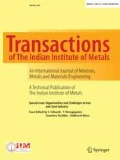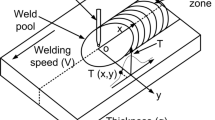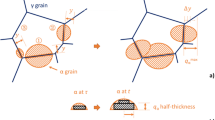Abstract
Grade P91 is a creep strength enhanced ferritic steel used widely at high temperature applications in thermal power plants. P91 weldments are subjected to post weld heat treatment (PWHT) at a typical temperature of 760 °C for stress relieving purpose and to obtain optimal mechanical properties. In general PWHT temperature is about 30–50 °C lower than the lower critical temperature (Ac1). Depending on the chemical composition (particularly Ni + Mn), heating rate and prior austenite grain size, Ac1 temperature can vary from 780 to 860 °C. In this investigation an attempt was made to understand the effect of surpassing the typical PWHT temperature of 760° and approaching Ac1 of the material. The investigation was based on physical simulation conducted using 3500 Gleeble thermo mechanical simulator. The study was performed on cylindrical specimens which were extracted from weld metal and parent metal. Specimens were subjected to normalizing treatment at 1050 °C for achieving austenitisation and to determine the Ac1 temperature and then to different PWHT temperatures in the range of 790–850 °C at suitable intervals. American Society for Testing and Materials (ASTM) A1033-10 based procedure was used to find Ac1 temperature for the parent metal and weld metal at slow heating rate condition to compare with practical heat treating condition. Dilatometry plots, microstructure and hardness tests performed on the specimen were used to analyse the phase transformation. Results indicated that alpha ferrite phase and fresh untempered martensite could be formed in P91 steel when PWHT temperature was about 12 °C less than the Ac1 temperature. It was also seen that the heating rate had strong influence on the Ac1 temperature. At the heating rate of 28°/hr, Ac1 was about 792 °C for weld metal, while Ac1 was about 812 °C for the heating rate of 220 °C/hr.










Similar content being viewed by others
References
Coleman K K, and Newell W F, Weld J August (2007) 29.
Patric D S, and Hans V W, Weld J, June (2006) 42.
Newell W F, Weld J, April (2010) 33.
ASM Handbook Committee, Metals Handbook, Heat Treating, vol. 4, 10th ed., ASM International, Metals Park, Ohio, (1991).
Krauss G, in Steels Heat Treatment and Processing Principles, ASM International, Metals Park, Ohio (1990).
Stout R D, Weld Res Counc Bull 302 (1985) 1.
Honeycombe R W K, and Bhadeshia H K D H, Steels Microstructures and Properties, 2nd ed., Edward Arnold, London (1995).
Hald J, Int J Pres Ves Pip 85 (2008) 30.
Haarmann K, Vaillant J C, Vandenberghe B, Bendick W, and Arbab A, The T91 Book, Vallourec and Mannesmann tubes, (2008).
ASTM A335 M, Standard Specification for Seamless Ferritic Alloy-Steel Pipe for High-Temperature Service. Table 1. P91 chemical requirements (2015).
ASME BPVC section II C, SFA 5.5 Specification for low alloy steel electrodes for shielded metal arc welding, (2015).
ASME BPVC section VIII Division 1, Table UCS-56-11, Post weld Heat Treatment Requirements for Carbon and Low Alloy Steels (2015), p 15E.
Lun Wang B S, Development of Predictive Formulae for the A1 Temperature in Creep Strength Enhanced Ferritic Steels, Graduate Program in Welding Engineering, Ohio State University (2010).
Raju S, Ganesh B J, Banerjee A, and Mohandas E, Mater Sci Eng A, 465 (2007) 29.
Michael Santella, Influence of Chemical Compositions on Lower Ferrite-Austenite Transformation Temperatures in 9Cr Steels, Editor: G.E.O. Widera, Proceedings of the ASME 2010 Pressure Vessels and Piping Division/K-PVP Conference, Bellevue, Washington, USA, July 18–22, (2010).
Masuyama F, Nishimura N, Proc ASME Press Vessels Pip Division Am Soc Mech Eng 476 (2004) 85.
Tokunagaa T, Hasegawa K, Masuyama F, Mater Sci Eng A 510 (2009) 158–161.
Alexandrov B T, Wang L L, Siefert J A, J K, Mach Technol Mater 4 (2012) 33.
Chen L, and Yamashita K, Weld World 56 (2012) 81.
McGehee A, and Coleman K, Optim Hardness P91 Weldments, EPRI Report (2003).
ASTM A1033-10 Standard Practice for Quantitative Measurement and Reporting of Hypoeutectoid Carbon and Low-Alloy Steel Phase Transformations, (2010).
Acknowledgement
Authors gratefully acknowledge the management of Welding Research Institute, BHEL Tiruchirappalli for the continuous encouragement and support.
Author information
Authors and Affiliations
Corresponding author
Rights and permissions
About this article
Cite this article
Vimalan, G., Ravichandran, G. & Muthupandi, V. Phase Transformation Behaviour in P91 During Post Weld Heat Treatment: A Gleeble Study. Trans Indian Inst Met 70, 875–885 (2017). https://doi.org/10.1007/s12666-017-1075-0
Received:
Accepted:
Published:
Issue Date:
DOI: https://doi.org/10.1007/s12666-017-1075-0




